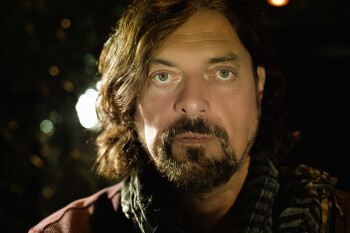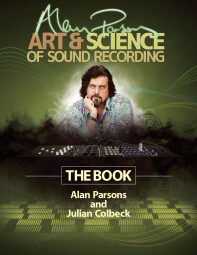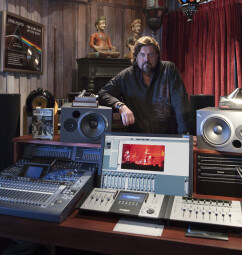Alan Parsons' career is as impressive as it is long. He got his start as an assistant engineer at the legendary Abbey Road Studios in London...
During that time he assisted on two Beatles albums, Abbey Road and Let it Be. Later, he received a Grammy nomination for his engineering work on Pink Floyd’s classic Dark Side of the Moon, and since then has worked with countless other major artists, as both an engineer and producer.
Parsons is also a recording artist, and has put out numerous records with his band, The Alan Parsons Project. In addition to producing his own music, he continues to produce various artists, and he’s also branched out into educating others on studio techniques. He created a 3-DVD series in 2010 with Julian Colbeck called The Art & Science of Sound Recording in which he shared his considerable studio expertise. The companion book, The Art & Science of Sound Recording — the Book (co-authored by Colbeck), was just released by Hal Leonard. The book also stands on its own as an excellent desktop reference for anyone who’s into recording.
Audiofanzine recently had the privilege to speak with Parsons about the book, studio techniques and a lot more.
Great book. It’s really comprehensive, but doesn’t go into ridiculous detail. Were you trying to make a desktop reference for recording musicians?
Basically, both the DVD series and the book were really intended to have a wide audience, not only existing engineers, budding engineers, but basically just laymen who had an interest in recording, because the recording studio has an air of mystery to most people. Everybody loves music, but very few people actually know how people achieve recording. It’s just an attempt to lift the lid on that, and at the same time get the views of other artists and engineers.
It’s cool that you included quotes in the book from a number of other well-known engineers, producers and musicians. An example is this one you got from Jack Joseph Puig about click tracks: “A real experienced musician understands the click track is his friend, and he knows how to play around it, and he knows how to play ball with it. The inexperienced musician hears a click track and goes, ‘Oh my gosh. That’s Hitler, and if I make a mistake I’ll be shot in the head, ’ and so they’re focused just on making sure that they’re nailing the click, nailing the click, which means the creative part of the brain is turned off.” Great quote. I always find a click to be helpful, but I’ve run into a lot of musicians who feel uncomfortable tracking to one. Do you prefer playing to a click?
I generally feel more comfortable with a click. I don’t think the music necessarily suffers.
Do you think it hinders the push and pull of the tempo that happens naturally?
You’ve got a point there. If I feel that is happening, then I’ll take the click away. It’s often so useful later for sequencing and referring to bar numbers and all that kind of stuff.
You offer a good tip in the book, to use a drum loop instead of a click, because it might be more comfortable to work with for a lot of people, since click sounds are often harsh.
I find the cowbell is always a nice click sound, rather than something that sounds like a click. It just feels more real that maybe somebody was actually playing it, than a click.
How did you decide what to include and what not to include in the book. You could have written it five times as long, if you wanted to.
It was designed to be a companion to the video series, so we didn’t want to deviate too far from the content of the DVD, perhaps because of the fear that one product might be considered as a superior product to the other.
How is the video version available?
It’s available as a complete series. It’s a physical 3-DVD set. You can also download the whole thing. You can download individual chapters. There’s another way of doing it where you get it on a USB stick, which currently is limited to educational licenses, but we’re contemplating putting that as being available to the public as well. It’s on an 8GB stick. It becomes a lot more interactive that way. You can jump to a particular subject and find all the references to a particular subject that you’re interested in.
How does the video compare to the book, content wise?
It essentially covers the same stuff. It’s just a little more personal, because I’m talking to the camera, and other people are talking to me. You get to get into the characters a bit. My own character included.
You give a lot of sonic examples, I guess, in the DVD version?
Yeah, that’s one advantage, of course. There is sound, and you hear the effect of EQ and compression and stuff, on the music that’s being played.
Billy Bob Thornton, who narrates the DVD series, has a good quote about how it’s very easy to ruin a song when overdoing it with delay. How do you know when you’ve come close to the point where adding any more of an effect like delay is going to stop being cool and start being annoying?
That’s the secret of being a good producer. If you’re going to do it, don’t overdo it. And knowing when to stop generally is the mark of a good producer. As we all know, projects are never finished, they are simply abandoned.
When you’re doing a mix, how do you know when you’ve reached the point at which it’s about as good as it’s going to get?
I always find mixing to be a sort of “it’s there or it isn’t there” situation. I don’t spend very long mixing. I’m happy if I can get two mixes a day finished, but often that’s not the case. But the tweaking and using the automation to just goose a word or a line, is something that I think makes it closer to perfection, if you like. I’m not looking for any variation. I’ve got a goal, and I’m just trying to achieve it. When I feel I have achieved it, then that’s it.
So you pretty much know what you’re going for from the beginning?
I wouldn’t say that so much, but once I’ve established what effects I’m going to use, what reverb I’m going to use, what’s going to be featured and the things that get taken in an out. Once I’ve established that then, yes, I’m very focused.
Do you work in Pro Tools, or some other DAW?
I have been working more in Pro Tools, but I also have used Cubase quite a bit.
Do you mix as you go, during tracking, so that you’re a lot of the way there by the time you focus on mixing?
I try to make it sound like a record immediately, so that I’m enjoying the recording process so that mixing becomes more of a formality.
So you’re not pulling everything down to 0 and starting from scratch before you start the actual mix phase?
Oh, I still do that. I like to think that I could push all the faders up and have a half decent mix. You know, it’s a reappraisal. Countless records have been mastered from rough mixes or monitor mixes, whatever you want to call them. Myself included. I remember hearing a rough mix, and then the final mastered mix and I couldn’t actually tell them apart.
Wow, and think of all the money they spent making that final mix and mastering it, and it was still hard to tell the difference. [laughs]
Exactly. [laughs]
So after you zero out everything, do you have a particular way in which you then move forward. Do you get a rough balance again and pan and then start adding effects, or do you focus on one element and get that sounding great and then move on to the next?
Most people start with drums and then add everything to the drums. I will start with the drums, but then I’ll take the drums out and look at everything else. And I like to get a balance of all the sort of rhythm instruments, and even the sweetening instruments, the orchestra or whatever. I like to get that all feeling good without the drums, and then you bring the drums in and it suddenly becomes a record.
In the book, you mention that you don’t like using master bus compression. Why is that?
Because I like to preserve dynamic range. It’s like listening to the difference between a CD and FM radio. FM radio has a different effect. I don’t particularly like it. I’m all in favor of preserving dynamic range, particularly drums. If you compress drums they go all wishy-washy. You lose the punch. It’s so strange, some people compress drums saying that it gives them more punch, but I don’t subscribe to that.
Some people use master bus compression for the “glue effect”— they feel like it helps make the mix more cohesive. You don’t buy into that?
I think that’s being weak willed. If you say you can only get things to gel with each other buy squashing them to oblivion then I don’t think you’ve done your job.
Even if it’s just light compression?
I’m happy with a little bit of brickwall compressing at mastering, but never at the mixing stage.
But obviously you use compression on individual tracks, like vocals.
Oh yes, of course. More often than not on bass.
But not on drums. [laughs]
Not on drums, yeah. Compression is great on occasion, for effect. A heavily compressed piano is a very distinctive sound, and fun to use now and again, but for just simply controlling the dynamics of a song, no, I’d steer away from it.
Do you use automation instead for those sorts of level-control tasks?
I’m more likely to just push a word or a line up and down. Automation is useful for that. I’ve been in the business long enough to know that you can do it without automation. Perhaps not on quite as many tracks as you have the luxury to access these days.
When you say doing it without automation, you mean manually pushing faders on the console during a mix?
Yeah. I made some perfectly good records without automation.
You must have had some of those situations where you have to ask the assistant engineer in to move a fader because you’re already got both hands on other faders and as does the producer.
Always better to use the assistant than one of the band.
They’ll turn themselves up loud, right? [laughs] Especially the guitarist [laughs].
I used to ban band members from the control room while actually mixing and then I would call them in and say “What do you think?” The guitarist would say the guitar wasn’t loud enough, the bassist would say it needs more bass. It’s just a series of compromises you have to make to keep everybody happy.
Speaking of control rooms, as someone who assisted on Beatles albums at Abbey Road and engineered for Pink Floyd on Dark Side of the Moon, you’ve obviously seen how the restrictions of the analog work flow caused musicians, producers and engineers to get really creative in order to accomplish their artistic vision. Do you think that the ease of manipulating and processing audio in today’s world of DAW recording might actually lead to less innovation and less creative magic because everything comes a bit too easily?
I think very few music creators have artistic vision. You record, you add things, you record the solos and vocals, you try effects, you mix. It’s all trial and error towards an ultimate goal of achieving something that works — not a preconceived vision. We worked hard to get effects that worked — remember back then there were no digital effects, no plug-ins. All time-based effects — delays, ADT and so on, were all based on tape machines, analog plate reverbs and a couple of Abbey Road-built 'magic boxes’. Modern hits seem to be all about obvious delay repeat effects, overuse of Auto-Tune and sterile programmed drum loops. Of course it’s still possible to record like the old days but it takes a conscious decision to have a band playing together and interacting, and to use restraint on effects. Just because they are available with a click of the mouse doesn’t mean they are necessarily right.
Can you recall a particularly memorable moment, from a production standpoint, that you observed when you were an assistant engineer for the Beatles? Perhaps something that impacted the way you work today?
One thing that stuck in my mind was that when The Beatles ran out of tracks, one solution was to record the overdub “wild” on another tape. George Martin had us record the orchestra on “The End" onto a separate 4-track, and we just hand synced it with the 8-track master on the mix. I’ve often filled an entire separate 24-track with backing vocals and then mixed them back to the master onto two tracks. No time code or anything — just pressing Play at the right time.
Who are you producing these days?
I’m about to do an Israeli artist named Aviv Geffen, and I’m going to Tel Aviv in January to work with him. He’s a huge star in Israel.
What’s his music like?
It’s fairly poppy. I’m looking forward to doing a pop record, for once. [laughs]
Are you doing any of your own musical projects?
I haven’t made an album under my own name since '04, but I’ve done a couple of singles. We’ve got a single out there now, and we’re playing it live. And I’m doing a double A-side vinyl release soon with that song and another new song. I’m kind of supporting the renaissance that vinyl is enjoying.
What do you like about vinyl? The warmth?
Yeah. And I think it’s fun to go back to the notion of sitting down and playing a record, which nobody does anymore.
What about from a fidelity standpoint?
It is hi-fi. It does sound good, if you can put up with the crackles and pops. I do enjoy listening to vinyl still. I’m not doing it a lot. The fact of the matter is I don’t listen to music that much. My normal delivery format for music is radio in the car. I’m just not likely to sit down and play music, except in the studio when I’m obviously working on something and I’ll play other people’s records as reference.
Last thing, can you describe your home studio?
There’s not a tape machine in sight. I have a Yamaha O2R96, I have a Mac Pro running Pro Tools and Cubase, and I have a reasonable mic collection. It’s a very compact, but circular studio.
Did you have it treated acoustically?
It was actually built as a studio by the two previous owners to myself.
So is it soundproofed — floating floors and all that?
I doubt it. [laughs] But it sounds good. The soundproofing is a problem. If I’m recording a quiet vocal and a plane flies over it’s a bummer. I don’t have neighbors, so the outgoing noise is not a problem. Dogs barking are a big problem. [laughs] We also have to schedule lawn mowing when I’m not recording.
Thanks very much!



